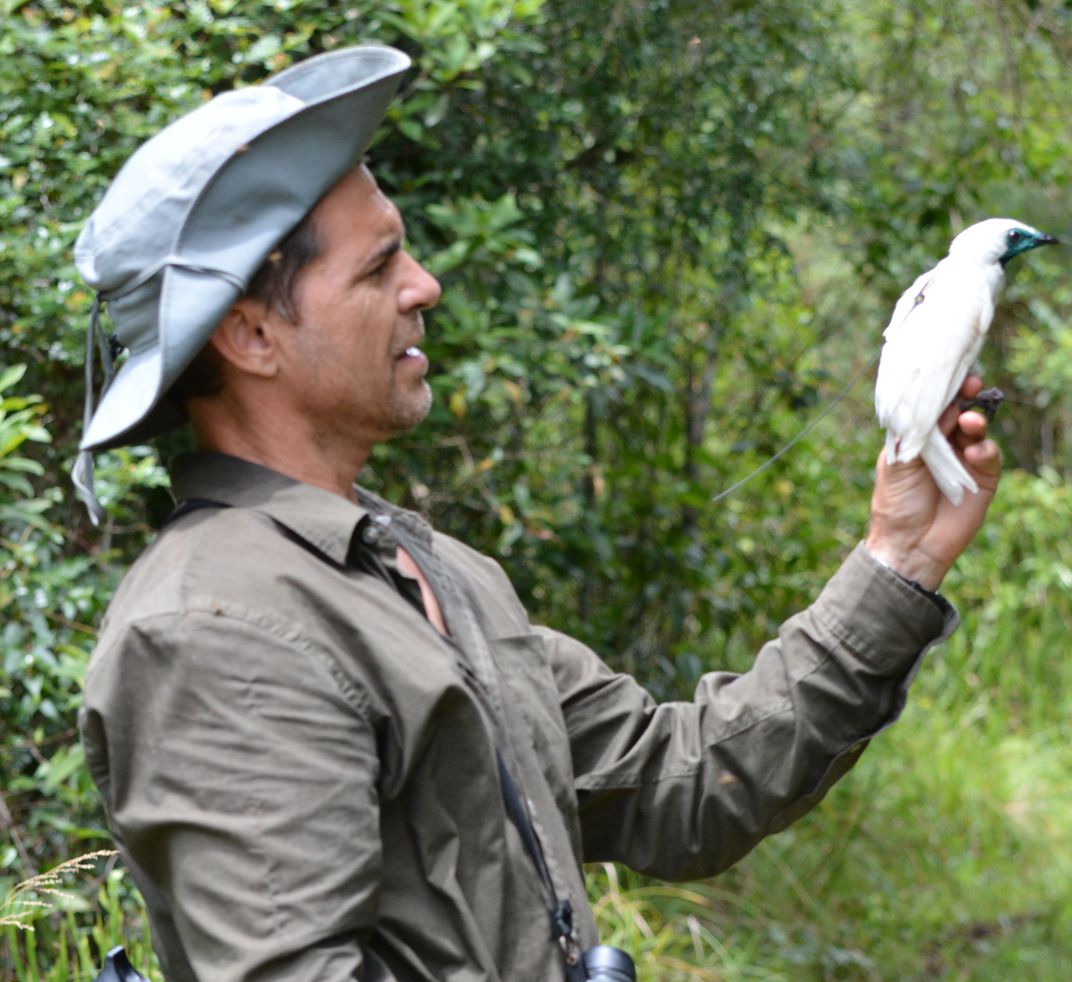Few species on Earth possess the striking qualities of the Bare-throated Bellbird. Its distinct call and bright plumage have made it a perfect target for both the illegal cage bird trade. Its status as a threatened migrant make it an important candidate for conservation and tracking efforts by Smithsonian scientists.

Average size: 27-29cm (11in)
Conservation Status: Vulnerable
Their plumage is sexually dimorphic: males are bright white with teal throats while females have mostly olive and yellow colored feathers.

A symbol of the plight of the Atlantic Rainforest, Bare-throated Bellbirds live exclusively in the Atlantic Rainforest of South America. This ecosystem, located along the eastern coast of Brazil, and extending inland to Argentina and Paraguay, is one of the most threatened on Earth, impacted by widespread habitat destruction due to conversion to agriculture, roads and urbanization. Every year, Bellbirds migrate across this ecosystem—a pattern that is poorly understood. These birds feed exclusively on fruit, and research to date on them suggests that they migrate to track seasonally available fruit across the forest. Yet, because we know so little about where they go at different times of year, we do not know the specific threats they face, making conservation efforts difficult.
The current number of Bare-throated Bellbirds is likely much smaller than in the past. They are considered a ‘Vulnerable’ species by BirdLife International, one of the organizations that track the status of birds around the world. The illegal cagebird trade, in which birds are taken from the wild to become pets, as well as habitat destruction have been the two main threats to this the Bellbird population. Males, the main target of the trade, have a spectacular, pure white plumage, and spend the breeding season singing from a high perch in the rainforest canopy. In contrast, females are olive and yellowish with streaking, and are rarely seen. In Brazil, Bare-throated Bellbirds may move up and down mountains in the Atlantic Rainforest, possibly nesting at the tops of these mountain ranges that are covered in forest, and then descending in the dry season to lower elevations, where more fruit is more available at that time of year. They may also migrate in a northerly or westerly direction after the breeding season, spending the non-breeding season in the rainforests of Paraguay and Argentina.

How are we studying Bellbirds? By employing the latest techniques and technologies, Smithsonian scientists are able to study the migration of these birds in unprecedented detail. The Bare-throated Bellbirds are captured in the Pro-Mata Nature Reserve in the state of Rio Grande do Sul, Brazil using a special net that’s hoisted into the rainforest canopy. After catching a Bellbird, a miniature satellite transmitter is carefully attached to its back that helps to track its location throughout the year. The data from the satellite transmitters helps scientists determine what migratory routes the Bellbirds utilize, the speed of these migrations, and where they spend the non-breeding season. To assess how these factors are influenced by their food sources, ‘point location’ data, which tell us where the bird is located on a given day, is overlaid onto satellite imagery that depicts climate and vegetation data. This allows Smithsonian scientists to get an estimate of the specific climatic (e.g., rain and temperature) and habitat conditions (size of forest patches) experienced by each Bellbird. Such satellite imagery also provides an estimate of habitat productivity, or amount of organic matter being produced by the environment, which serves as an estimate of the food available to the birds. Finally, using sophisticated computer models, scientists are able to precisely describe each Bellbird’s migratory routes, speed of movement, climate it’s experiencing, and food available to it at the places it stops to forage. Using that data, conservation and management plans can be designed that take into account the specific needs of this unique species throughout the year, helping to ensure the Bare-throated Bellbird’s long-term preservation.
Director, Georgetown Environment Initiative
Laudato Si' Professor of Biology and the Environment Georgetown University Emeritus Senior Scientist, Migratory Bird Center Smithsonian Conservation Biology Institute National Zoological Park
Research Scientist
Smithsonian Conservation Biology Institute Migratory Bird Center National Zoological Park
Post-Doctoral Research Fellow
Smithsonian Conservation Biology Institute Migratory Bird Center National Zoological Park
Jahn, A. E., Levey, D. J., & Smith, K. G. (2004). Reflections across Hemispheres : A System-Wide Approach to New World Bird Migration Author ( s ): Alex E . Jahn , Douglas J . Levey and Kimberly G . Smith Published by : American Ornithological Society Stable URL : http://www.jstor.org/stable/4090470 REFE, 121(4), 1005–1013.
